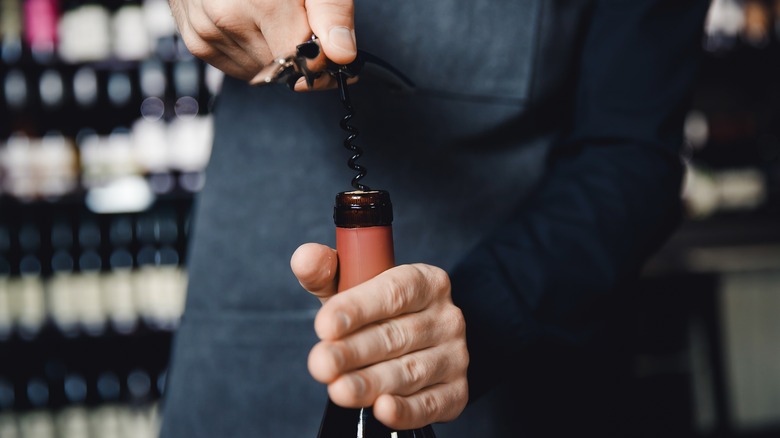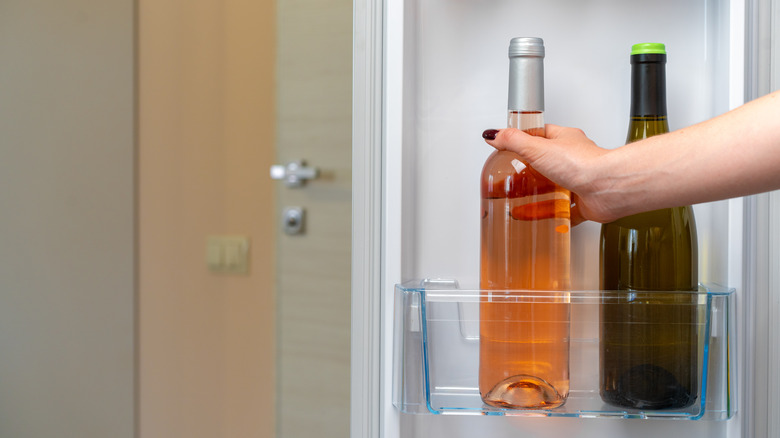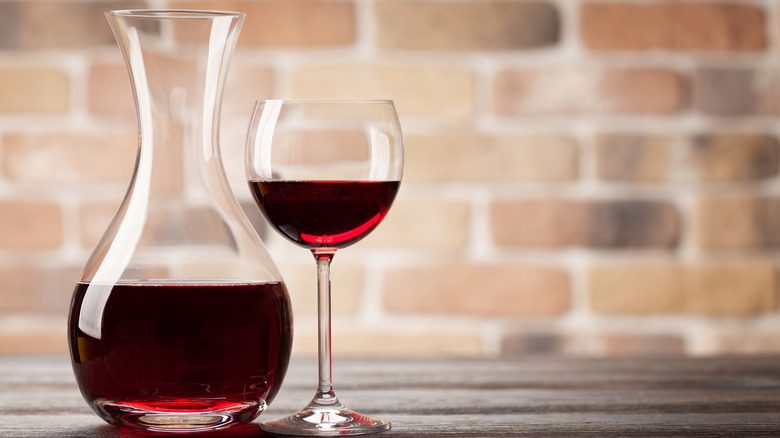The Best Way To Store An Open Bottle Of Wine
Actress Dame Joan Collins famously quipped, "Age is just a number. It's totally irrelevant unless, of course, you happen to be a bottle of wine," via Wine Folly. And, she has a point. It's why, according to Bloomberg, a 2019 bottle of Bordeaux clocks in at around $400, and a 2010 vintage Bordeaux can easily command $1,000, says Wine Searcher.
But, when it comes to wine, older might not always be better. Even though a bottle might improve and deepen with age, all bets are off after it's been opened. Wine begins to deteriorate the second it's exposed to oxygen, a process called oxidation. It's a series of chemical reactions that occur when wine is over-exposed to air, causing it to increase in acidity and lose flavor, per Decanter. According to Wine Country, oxidation is the culprit that turns good wine sour. In fact, sour might be exactly the right word –- too much oxygen, it says, eventually turns wine into vinegar. Sound enticing?
Luckily, there's an easy way to store an open bottle and keep it fresh into day two, or three, or however long you prefer to savor those sips. Follow these tips to stave off oxidation and keep an uncorked bottle fresh. (We see you, boxed wine.)
Cool sommeliers love the fridge
Wine purveyor Kendall-Jackson recommends storing wine in a cool, dark place — ideally, the refrigerator. Simply reuse the original cork (or a wine stopper) to plug up the bottle and pop it in the fridge. When recorking, Wine Enthusiast advises putting the stained side of the cork back in first. Even though it might seem easier to fit the unstained side in the bottle, that side has also been exposed while sitting on the shelf at the wine store, being transported in a cargo truck, and during virtually all of the manufacturing process. To prevent any potential bacteria from seeping into your wine, better to plug it using the stained side.
To minimize the surface area of wine that is exposed to oxygen, Wine Folly suggests storing the bottle upright rather than on its side. If your refrigerator shelves are short, or there isn't room on your fridge door, make room. Your wine will thank you. For wines best served at room temperature, like most reds, Kendall-Jackson says, you can leave them on the countertop for 30 minutes to warm without affecting the flavor profile too much, or run the bottle under lukewarm water. In the fridge, white wine will last three to five days, with higher acidity level wines lasting longest, while low tannin reds will last up to three days and high tannins up to five, per Martha Stewart.
Turn to technology
Technology has transformed the modern kitchen, and wine preservation is no exception. The decanter traditionally is one of the most basic, no-frills tools in the sommelier's arsenal. To get the freshest sip from a day-old bottle, MasterClass suggests pouring your stored wine through a decanter to aerate.
But tech-savvy wine enthusiasts might consider using a mini wine cooler (like this 18-bottle model from Kalamera). The ideal temperature for storing both red and white wine is 55 degrees Fahrenheit, per Sommelier's Choice Award. However, says Home Depot, the optimal temperature for refrigerators is a cool 37 degrees Fahrenheit. A wine cooler will keep your bottles, open or closed, maintained at the ideal temperature.
If a wine fridge is a bit large for your taste, there are handheld options for fresher wine, too. The Coravin is a relatively new device specifically made for folks who won't finish a bottle of wine in one sitting. The device anchors around the neck of your wine bottle and punches a hole through the center of the cork with a thin needle. The needle acts like a spout through which wine can pass, so you can pour a glass without removing the cork. When you're finished, simply remove the Coravin from the bottle, and the naturally porous cork will expand and fill the tiny hole made by the needle.


